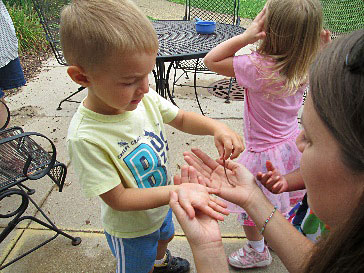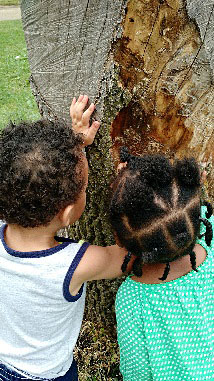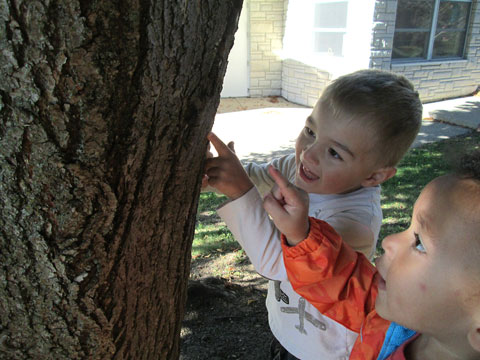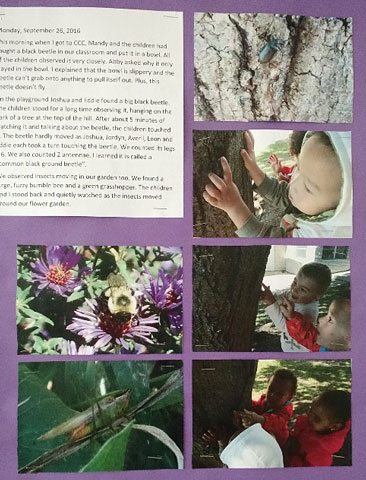Kendra Nenia and Denise Fenn
Northern Illinois University Campus Child Care Center
2016
Our project was completed in a full-day childcare classroom at Northern Illinois University’s Campus Child Care Center. The children in the classroom were 2 and 3 years old. The study lasted six weeks.
Phase 1: Beginning the Project
We post documentation of classroom activities in the hallway, and we noticed insects appeared multiple times. The children wanted to dig for worms and look for insects, including arachnids and arthropods, in our gardens, and they continued to notice insects and spiders in the classroom and outdoors. We also noticed that the children asked about insects repeatedly. They also were interested in reading children’s books related to the topic.
We shared our observations of the children’s interest with families. A majority of the parents said, “YUCK!” or “Better you than me.” Although we experienced these responses from parents, we decided to follow the children’s interests.
To encourage the children’s curiosity, we used some “I wonder…” questions throughout the study. We modeled different interactions with the insect world, showing insects can be beautiful, cool, and interesting.



Because the children in our classroom are as young as 2 with a few new 3 year olds, they did not have a lot of prior knowledge or experience with insects. Therefore, we sought out every opportunity to interact with the insect world, keeping it interesting, safe, and inviting. We wanted to spur on the children who showed some interest in the insect world and encourage them to dig a little deeper. We were hopeful the children who were less interested would start to notice the insects around them and not be repulsed. So, we encouraged the children to express curiosity and notice the many attributes insects have.
Phase 2: Developing the Project
On the playground, the children would ask for help turning over stumps to look for worms. The children also would search for all sorts of insect life in the flower garden we had planted during a previous study. When we noticed how often this was happening, we provided more opportunities for this type of investigation.
We would say “I wonder…” and then make a statement that might spur some interest. As we investigated, the questions were very simple and mostly lead to opportunities to recall our previous questions such as “I wonder if bugs have bones?” or “I wonder how many legs a spider has?” There was not a lot of change other than broadening the study of insects. The children’s focus was steady, and they continued to find insects just about everywhere. We also found many images online and in children’s literature with detailed photographs. For example, books such as The Very Busy Spider by Eric Carle were simple lead-ins to deeper investigations of spiders.
We tried to connect the Entomology Department on campus, but they did not have time/staff to allow us to visit, so we used what we had at our fingertips. We are fortunate to have a very large playground, with many spaces where insects could be found, so we used that space often. Kendra’s husband had taken an entomology course, so he had preserved a variety of insects. In addition, he had recently received a donation of insects from a professor at a major university. She brought in his collections for the children to examine more closely, which allowed the children to see insects they normally would not encounter. For example, we saw the exoskeleton of a tarantula in one of the cases, as well as a variety of butterflies. In addition, one of our teacher’s aides had a pet tarantula, so she brought it in and answered our questions. We observed it closely—it was very still!



The parents also became involved in the investigation. They put aside their initial “eeww yuck!” responses and brought in spiders and insects they had found in their houses. They asked their children questions about what they had learned. This was a tough study for parent involvement because most parents were disgusted by the thought of handling insects and arachnids.
Phase 3: Concluding the Project
The children learned very basic knowledge about insects—number of legs, where they are found, how they are to be handled, and what arachnids and insects can offer humans. Throughout the study they learned to use a calm disposition when dealing with insects. They were constantly encouraged to ask questions.
Most of the learning was experiential and was represented on our study bulletin board, throughout the room, and through documentation on Teaching Strategies Gold. We documented the study through photographs and write-ups of what was seen, the children’s words and reactions, and the learning standards addressed according to Teaching Strategies Gold definitions and concepts. We have a large board in our room and frames in our hallway for documentation. We chose not to have a culminating event. We followed the children’s interest, even when their interest tapered off. Children’s interest in a topic can ebb and flow, and so we as teachers should scaffold, not push, when studying a subject with very young children.


Teacher Reflection
Kendra’s reflection: As teachers, we learned to slow down and watch. More questions and learning happened through observations than anything else during this study. When I slowed down and watched or listened, so did the children. The topic itself was surprising. I would not have chosen this topic for the children—ever!
It was surprising how long the children stayed interested in this topic. I think because it was easy to access insects on our playground, the learning and exploration kept going. The insect world also was a good topic because it followed the children’s interest. I feel if I expect the children in my classroom to learn about anything, it has to be interesting and fun to them.
As we studied insects, the children who started out fearful of all insects gained experiences that made them more comfortable with the bug world. Parents who were not excited about insects asked questions and got involved by bringing in insects and arachnids they had found around their homes. It kept the children’s interest going because the parents were interested too!
Were we to do a similar project, I would preserve some insects with the children’s help; this could give the children an even closer look at insects. I also would consider having a pet from the insect or arachnid world. This could give the children a daily interaction with creatures that are an integral part of our world. It could spur on wonder, encourage respect, and teach the children how to care for living things.
IEL Resources
- Resource list: Teaching and Learning about Insects

